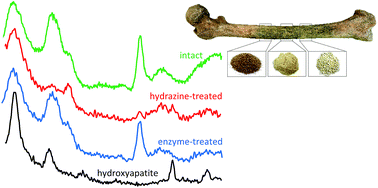Biomaterials from human bone – probing organic fraction removal by chemical and enzymatic methods
Abstract
Two different deproteination and defatting processes of human bone were investigated, by combined infrared and neutron techniques: a previously reported hydrazine extraction and a newly developed multi-enzymatic treatment. Complementary Fourier transform infrared total attenuated reflectance and inelastic neutron scattering spectroscopies were applied, allowing access to all vibrational modes of the samples. The effectiveness of the different experimental protocols for removing the organic constituents of bone (lipids and protein) was probed, as well as their effect on bone's structural and crystallinity features. The results thus gathered are expected to have an impact on bioanthropological, archaeological and medical sciences, namely regarding the development of novel biocompatible materials for orthopaedic xenografts.



 Please wait while we load your content...
Please wait while we load your content...